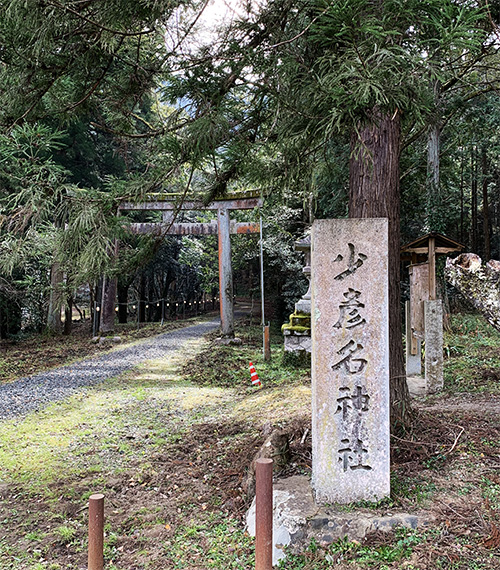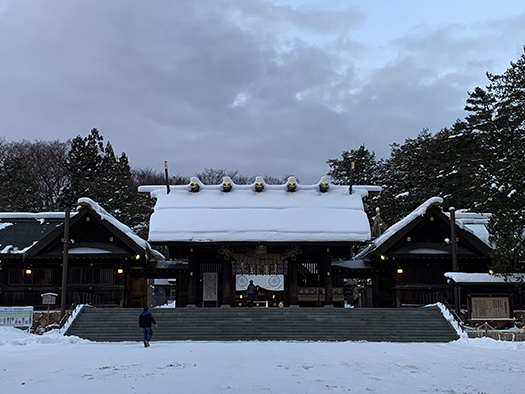

さてわたしは昨日までブログの取材をメインに四国行脚の旅。
住宅や建築についての探訪取材がメインの人生テーマなので、
それを表現するブログ記事は一種の自己確認の手段でもあり、
そのテーマに則して基本的に日本全国で「建築民俗」を巡っています。
今回ははじめて本格的に「四国」を巡って見た次第。
北海道と四国というのは、なかなか点と線が繋がらない。
一応わが家は真言宗徒なので八十八箇所という縁もあるかも知れませんが
それはもっと人生最終盤にでも行脚することになるでしょう(笑)。
いまのところ古建築・古民家を巡って日本人と住環境の掘り起こしがメイン。
都合5日間だったので足が痛くなるほどにあちこちを行脚。
昨日帰ってきましたが、さっそく冬の大嵐ふうの暖気と大雪が出迎え。
さっそく早朝からの雪かきに追われそうです(泣)。
で、そういう一見の無関係性のなかで突然、引きずり込まれたのがこちらの
「少彦名神社」であります。
たまたま訪れた愛媛県・大洲の町行脚時に高速出口付近の交通案内で
この名前を見つけさせられて、一気に北海道との御縁の深さに驚愕。
そしてその故地を訪れさせていただいたことに深く感謝。
この少彦名命とは北海道神宮が創始されたときに明治帝が遣わされた
開拓三神のなかの「国土経営の神さま」ともいえる存在であります。
開拓三神とは、北海道神宮などに祀られている三柱の神の総称。
・大国魂命 – 国土そのものの神霊
・大己貴命 – 国造りの神
・少彦名命 – 国造りの協力神
ということなのですが意味合いとしては、明治の北海道開拓に際して
大国主の国造りと同じような日本民族の大事業であるという認識から
この少彦名命に白羽の矢が立てられたということのようです。
で、神格としてはさまざまないわれがあるとされますが、
少ない物資でも経営的に工夫して人々が生き永らえていくことができるように
という「中小零細企業」的な国土経営マインドを根付かせたいということ。
その願いの神格として北海道神宮に派遣されたと読み解くことができる。
北海道の開拓時には当然すぐに食べられるものは生産できないので
少ない資源を知恵と工夫で活用して国土を豊かに営め、という民族意思。
それを知ってからこの神さまに深く親近感を持っていました。
この大洲で神社拝殿に参詣させていただき、お会いした氏子の方々に
お話を伺わせていただいて、その民族意思の深遠さに思わず頭が下がった。
この神さまは大国主の国造りの協力者として活躍された後、
この地に帰ってこられてこの社に睡っておられるのだというのです。
神社というのはもちろん民族ファンタジーではあるけれど、
それを超越して民族としてのありよう、倫理観を示していると思います。
いまも北海道で国土経営の最前線で奮闘されておられる神々しさ。
そういう縁を知ることができたよろこびも深い。
English version⬇
[“Sukuna bi kona” god enshrined in Hokkaido Jingu from Shikoku Ehime]
By the way, until yesterday, I mainly traveled to Shikoku, focusing on blog coverage.
My main life theme is exploration and coverage of housing and architecture.
The blog article that expresses it is also a kind of self-confirmation means,
Based on that theme, I basically go around “architectural folklore” all over Japan.
This time, I saw “Shikoku” in earnest for the first time.
In Hokkaido and Shikoku, it is difficult to connect dots and lines.
Since my family is a Shingon sect, there may be 88 places.
It will be more pilgrimage to the final stage of my life (laughs).
So far, the main focus is on digging up the living environment with Japanese people over old architecture and folk houses.
It was 5 days, so I went around so much that my legs hurt.
I came back yesterday, but the warmth and heavy snow of a heavy winter storm greeted me.
I’m about to be chased by snow shoveling from early morning (crying).
So, in such a seemingly irrelevant situation, I was suddenly dragged in here.
It is “Sukunahikona Shrine”.
When I happened to visit the town of Ozu, Ehime prefecture, I used the traffic guide near the highway exit.
I was made to find this name and was amazed at the depth of the connection with Hokkaido at once.
And I am deeply grateful to have visited the hometown.
This Shohiko name was sent by the Meiji Emperor when the Hokkaido Jingu Shrine was founded.
It can be said to be the “god of national land management” among the three pioneering gods.
Pioneer Sanjin is a general term for the three pillar gods enshrined in Hokkaido Jingu Shrine.
・ Kunitama soul life-the spirit of the land itself
・ Okuninushi-The god of nation-building
・ Sukuna bi kona — a nation-building cooperation god
However, the implication is that when the Meiji era was cultivated in Hokkaido.
From the recognition that it is a big business of the Japanese people similar to the country building of Okuninushi
It seems that a white arrow was erected in this name of Sukunahikona.
So, it is said that there are various deities as deities,
So that people can survive by devising management even with a small amount of supplies
I want to take root in the national land management mindset of “small and medium-sized enterprises”.
It can be read that he was dispatched to Hokkaido Jingu Shrine as the deity of that wish.
Of course, when you develop Hokkaido, you can’t produce something that you can eat right away.
The national will to enrich the country by utilizing scarce resources with wisdom and ingenuity.
Since I knew it, I had a deep sense of familiarity with this god.
To the children I met when I visited the shrine worship hall in Ozu
When I heard the story, I was struck by the depth of the national will.
After being active as a cooperator of Okuninushi’s nation-building, this god
He is said to have come back to this place and is sleeping in this company.
Of course, a shrine is a folk fantasy, but
Beyond that, I think it shows ethics as a race.
The godliness that is still struggling at the forefront of national land management in Hokkaido.
I am very happy to know such a connection.
Posted on 1月 12th, 2022 by 三木 奎吾
Filed under: 住宅マーケティング, 日本社会・文化研究







コメントを投稿
「※誹謗中傷や、悪意のある書き込み、営利目的などのコメントを防ぐために、投稿された全てのコメントは一時的に保留されますのでご了承ください。」
You must be logged in to post a comment.